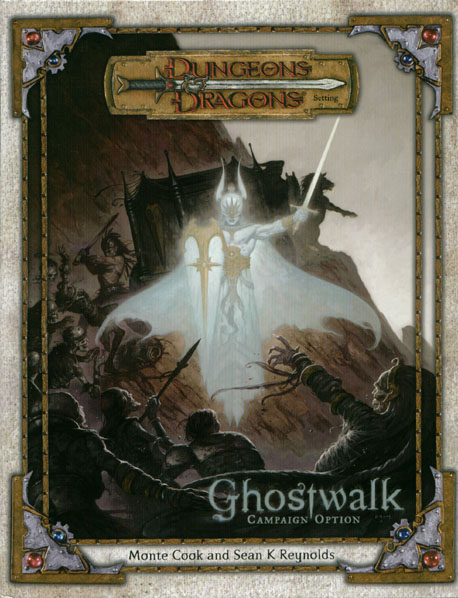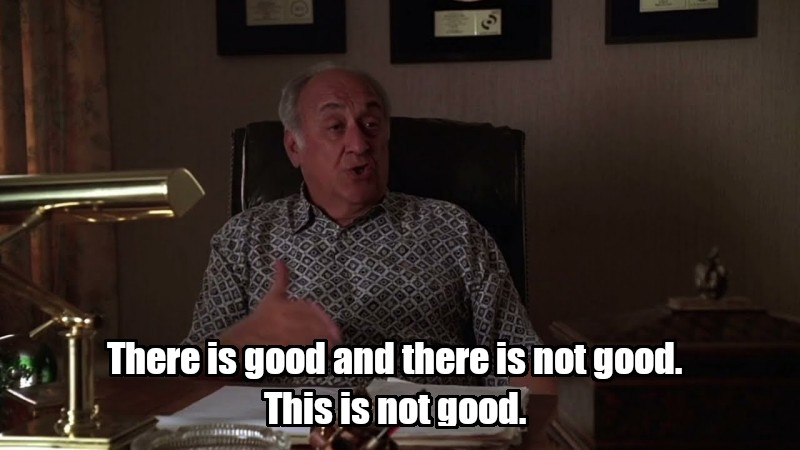 Ghostwalk came out in 2003, three years after the release of Dungeons & Dragons 3rd edition and just before the new revised rulebooks came out. It’s a book that I see getting mentioned every other year or so and that always seems to be fondly remembered by a few people. However, in the almost 20 years since its release now, I have never heard of even a single person mentioning a campaign or even just a one-shot adventure that was actually played in this setting. Looking through some other early 3rd edition stuff these last days, and thinking about games with this system that I always wanted to run but never actually did, had me of course reminded of Ghostwalk.
Ghostwalk came out in 2003, three years after the release of Dungeons & Dragons 3rd edition and just before the new revised rulebooks came out. It’s a book that I see getting mentioned every other year or so and that always seems to be fondly remembered by a few people. However, in the almost 20 years since its release now, I have never heard of even a single person mentioning a campaign or even just a one-shot adventure that was actually played in this setting. Looking through some other early 3rd edition stuff these last days, and thinking about games with this system that I always wanted to run but never actually did, had me of course reminded of Ghostwalk.
The whole idea behind Ghostwalk is that characters who die on their adventures aren’t simply gone from the campaign unless the party can arrange for the characters to be resurrected with a raise dead spell, but instead continue their adventures as a ghost. That alone was a big draw for me when this book was announced, and I was actually surprised when it turned out to be a campaign setting. It’s centered around a city of the dead outside the gateway to the afterlife, with some brief additional information about the surrounding lands. That sounds quite cool, but it never managed to get me even starting on a preliminary concept for an actual campaign, and from everything I’ve seen about the setting since then, very few other people did either.
So I sat down again with the book, and after literally decades since I first read it, tried to find my footing again with the basics of the world and what kinds of adventures it is setting up. And as it turns out, for a 220 page book, there is stunningly little in the way of material that would inspire adventure. When you first hear the idea of a land where the dead don’t actually die, it might sound really cool and make you want to know more. But there really doesn’t seen to be much more.
The central nexus of the setting is the gateway to the afterlife, though which all the souls of dead people have to cross. As these souls are getting close to the gateway, they start to gain the traits of ghost, gaining the ability to be seen and heard, manipulate physical objects, and eventually take on a semi-solid form. Most souls simply pass through the gateway right away, but some hesitate out of a fear of the unknown beyond, or because there is something in the world of the living that they can’t make themselves leave unfinished. And so, over the ages, a whole city has risen up around, and now high above the gateway. Populated by the ghosts who are struggling with the fear of what awaits them in true death or hoping that someone from their past life will try to meet them in the city of Manifest to settle the things that keep them. Because the existence of the city is well known in the surrounding lands and people frequently make the journey in the hope of being able to talk with the dead one more time before they are truly gone.
Where things get a bit muddled is that there is also the practice of taking the bodies of the dead to the gateway to reunite them with their souls in the afterlife. This is where the whole thing starts to feel implausible to me. Is the gateway in Manifest the only one in the world? From how far away are the spirits of the dead coming to pass through it and perhaps linger outside of it for some months or years? Does all the world know about its existence, or is this something known only in the neighboring countries? Is it a local custom to try sending the bodies into the afterlife as well or a global thing? Is it something for the super rich and powerful, or is it a common practice for everyone but the poorest? What about the people who just get buried in this world? Are they condemned to an eternal afterlife in an incomplete state? The idea of having these funeral processions from distant lands coming through the streets of the city every day is very evocative, but it feels really not thought through.
And what about conflicts? The main antagonists that the setting describes are the Yuan-ti. Yuan-ti abominations are not humanoids and as such don’t have spirits that travel to the gateway and manifest as ghosts. And because of that the yuan-ti want to destroy the city. That’s not enough of a motivation for villains outside of superhero comics and it doesn’t really give you anything to work with then coming up with adventures. Necromancers are hated but also really interested in the city, but I wasn’t really able to find out why. What about the ghosts? They populate the city and mingle with the living, but what kind of things would they be up to that could set up an adventures for PCs?
And beneath the city is a giant maze of old ruins called the Catacombs. But if the city is build around a gateway to the afterlife and people bring bodies to the city to move then through it, why does the city have catacombs? Maybe it’s just a name, but a city of the dead with giant catacombs that don’t actually have any dead bodies in them would be kind of lame. Also, what do the living people who build the city around the gateway actually do there? The dead don’t need any of the things that a normal economy provides for the living. Is it all about catering to the living travelers coming to drop of a body or hope to catch a ghost before it departs?
What really amazes me is how this book manages to reach 220 pages. There is so much text that goes on an on about things without actually saying anything interesting. The rules for ghost characters also seem way too complicated. This book has over 80 new feats. Nobody needs that.
In hindsight, I can fully understand why you never hear about anyone ever having played a campaign in Ghostwalk or used the rules for semi-dead PCs.
 The elevator pitch sounds like something that could be made into something really interesting. When I picked the book up again, I was thinking that this could be a great opportunity to make a campaign that draws heavily on the Dark Souls and Legacy of Kain series. And while that still seems like it could be a cool campaign, I think all the work needed to make that interesting would leave very little of the setting material that is actually present in the book.
The elevator pitch sounds like something that could be made into something really interesting. When I picked the book up again, I was thinking that this could be a great opportunity to make a campaign that draws heavily on the Dark Souls and Legacy of Kain series. And while that still seems like it could be a cool campaign, I think all the work needed to make that interesting would leave very little of the setting material that is actually present in the book.
